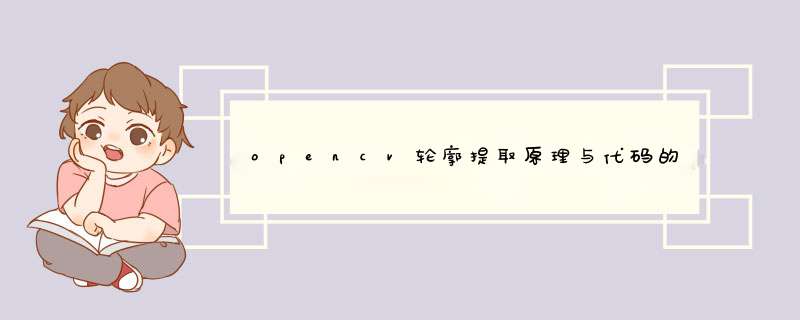
在检测物体的轮廓时,我们通常会使用到opencv中的findcontour和drawcontour,比较常用而且效果不错。那么findcontour是基于什么原理来实现轮廓的提取呢?
轮廓的提取与描述在目标识别中我们首先要把感兴趣的目标提取出来,而一般常见的步骤都是通过颜色或纹理提取出目标的前景图(一幅黑白图像,目标以白色显示在图像中),接下来我们要对前景图进行分析进一步地把目标提取出来,而这里常常用到的就是提取目标的轮廓。
OpenCV里提取目标轮廓的函数是findContours,它的输入图像是一幅二值图像,输出的是每一个连通区域的轮廓点的集合:vector《vector《Point》》。外层vector的size代表了图像中轮廓的个数,里面vector的size代表了轮廓上点的个数。下面我们通过实例来看函数的用法。
view plain copy print?
int main()
{
using namespace cv;
Mat image=imread(“。。/shape.png”);
cvtColor(image,image,CV_BGR2GRAY);
vector《vector《Point》》 contours;
// find
findContours(image,contours,CV_RETR_EXTERNAL,CV_CHAIN_APPROX_NONE);
// draw
Mat result(image.size(),CV_8U,Scalar(0));
drawContours(result,contours,-1,Scalar(255),2);
namedWindow(“contours”);
imshow(“contours”,result);
waitKey();
return 0;
}
int main()
{
using namespace cv;
Mat image=imread(“。。/shape.png”);
cvtColor(image,image,CV_BGR2GRAY);
vector《vector《Point》》 contours;
// find
findContours(image,contours,CV_RETR_EXTERNAL,CV_CHAIN_APPROX_NONE);
// draw
Mat result(image.size(),CV_8U,Scalar(0));
drawContours(result,contours,-1,Scalar(255),2);
namedWindow(“contours”);
imshow(“contours”,result);
waitKey();
return 0;
}
上面程序中包含了2个函数,第一个是查找轮廓函数,它的第三个参数说明查找轮廓的类型,这里我们使用的是外轮廓,还可以查找所有轮廓,即
包括一些孔洞的部分,像图像人物胳膊与腰间形成的轮廓。第4个参数说明了轮廓表示的方法,程序中的参数说明轮廓包括了所有点,也可以用其
他参数让有点直线的地方,只保存直线起始与终点的位置点,具体参数用法可以参考手册里函数的介绍。
第二个函数drawContours是一个画轮廓的函数,它的第3个参数程序里设置-1表示所有的轮廓都画,你也可以指定要画的轮廓的序号。
提取到轮廓后,其实我们更关心的是如果把这些轮廓转换为可以利用的特征,也就是涉及到轮廓的描述问题,这时就有多种方法可以选择,比如矢
量化为多边形、矩形、椭圆等。OpenCV里提供了一些这样的函数。
[cpp] view plain copy print?
// 轮廓表示为一个矩形
Rect r = boundingRect(Mat(contours[0]));
rectangle(result, r, Scalar(255), 2);
// 轮廓表示为一个圆
float radius;
Point2f center;
minEnclosingCircle(Mat(contours[1]), center, radius);
circle(result, Point(center), staTIc_cast《int》(radius), Scalar(255), 2);
// 轮廓表示为一个多边形
vector《Point》 poly;
approxPolyDP(Mat(contours[2]), poly, 5, true);
vector《Point》::const_iterator itp = poly.begin();
while (itp != (poly.end() - 1))
{
line(result, *itp, *(itp + 1), Scalar(255), 2);
++itp;
}
line(result, *itp, *(poly.begin()), Scalar(255), 2);
// 轮廓表示为凸多边形
vector《Point》 hull;
convexHull(Mat(contours[3]), hull);
vector《Point》::const_iterator ith = hull.begin();
while (ith != (hull.end() - 1))
{
line(result, *ith, *(ith + 1), Scalar(255), 2);
++ith;
}
line(result, *ith, *(hull.begin()), Scalar(255), 2);
// 轮廓表示为一个矩形
Rect r = boundingRect(Mat(contours[0]));
rectangle(result, r, Scalar(255), 2);
// 轮廓表示为一个圆
float radius;
Point2f center;
minEnclosingCircle(Mat(contours[1]), center, radius);
circle(result, Point(center), staTIc_cast《int》(radius), Scalar(255), 2);
// 轮廓表示为一个多边形
vector《Point》 poly;
approxPolyDP(Mat(contours[2]), poly, 5, true);
vector《Point》::const_iterator itp = poly.begin();
while (itp != (poly.end() - 1))
{
line(result, *itp, *(itp + 1), Scalar(255), 2);
++itp;
}
line(result, *itp, *(poly.begin()), Scalar(255), 2);
// 轮廓表示为凸多边形
vector《Point》 hull;
convexHull(Mat(contours[3]), hull);
vector《Point》::const_iterator ith = hull.begin();
while (ith != (hull.end() - 1))
{
line(result, *ith, *(ith + 1), Scalar(255), 2);
++ith;
}
line(result, *ith, *(hull.begin()), Scalar(255), 2);
程序中我们依次画了矩形、圆、多边形和凸多边形。最终效果如下:
对连通区域的分析到此远远没有结束,我们可以进一步计算每一个连通区域的其他属性,比如:重心、中心矩等特征,这些内容以后有机会展开来写。
以下几个函数可以尝试:minAreaRect:计算一个最小面积的外接矩形,contourArea可以计算轮廓内连通区域的面积;pointPolygenTest可以
用来判断一个点是否在一个多边形内。mathShapes可以比较两个形状的相似性,相当有用的一个函数。
欢迎分享,转载请注明来源:内存溢出

 微信扫一扫
微信扫一扫
 支付宝扫一扫
支付宝扫一扫
评论列表(0条)